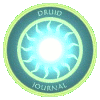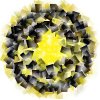For some notes on the origin and meaning of Alban Elued, see this previous post.
 Our family’s Alban Elued ritual is drawn directly from the pages of John Michael Greer’s Druidry Handbook. It is in no way supposed to be a reconstructed ritual, a reenactment of what ancient Druids performed 2000 years ago. Almost nothing is known about their rituals or holidays. Instead, this is a ritual of the Druid Revival tradition, which mixes elements of known Celtic mythology with Arthurian romances and 19th-century mysticism. The overall effect is eclectic and hermetic, infused throughout with nature symbolism.
Our family’s Alban Elued ritual is drawn directly from the pages of John Michael Greer’s Druidry Handbook. It is in no way supposed to be a reconstructed ritual, a reenactment of what ancient Druids performed 2000 years ago. Almost nothing is known about their rituals or holidays. Instead, this is a ritual of the Druid Revival tradition, which mixes elements of known Celtic mythology with Arthurian romances and 19th-century mysticism. The overall effect is eclectic and hermetic, infused throughout with nature symbolism.
Quite apart from that, the wording is lovely. It has some great passages such as “those who established the turnings of the silent stars” and “from the rising sun, three rays of light / From the green earth, three stones of witness / From the eye and mind and hand of wisdom / Three rowan staves of all knowledge.” Great stuff.
We did decide to make some changes. First, the ritual invokes a god: Esus, spirit of oak trees. Esus may be a great god and all, but he is not familiar to me personally; and I don’t know about you, but I’m a little uncomfortable about inviting strange gods into my home (or my Sacred Grove). So we replaced “Esus” with “the spirit of the trees”. Maybe that’s the same thing, but we felt more comfortable about it.
Second, the Arthurian influence on Revival Druidry is very obvious in the last part of the ritual. There, we are called upon to raise a sword over our heads and praise Excalibur, sword of swords, forged with earth, air, fire, and water. I probably would’ve been fine with this in high school or college, but I would feel a little weird about brandishing a sword in front of my small children. So we just cut that part out entirely. I’m a little worried that we are leaving out something important — it may be that Excalibur serves some vital purpose in the ritual — but I don’t know what that is, so I don’t know what to replace it with. In the future I’ll research that and figure something out.
For my wife and I, the most important part of these rituals are not the names of the gods or spirits we invoke, but the sense of awe and reverence that the rituals evoke in us and the children. When I was growing up, the only way we marked the changing seasons was by turning off the air conditioner and turning on the heater. We might as well have been living in a space capsule. Connection with nature can provide a vital sense of grounding, as Steve Pavlina points out here. For a druid, nature is the direct link with the eternal.
In any case, we couldn’t do the ritual this weekend, because my wife was sick with a head cold. We’ll just do it next weekend. That’s actually a good thing, because it will give me more time to memorize the ritual. My performance at Lughnasadh a left a lot to be desired…





Leave a comment